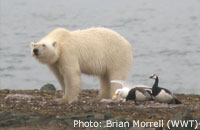Polar bears found preying on the eggs of Barnacle Geese on Svalbard
 Bonn,
Bonn,
31 August 2010 - A recent Arctic expedition by an international
research team has confirmed that polar bears are increasingly
found depredating the nests of Barnacle Geese (Branta
leucopsis) on a number of small offshore islands along
the western coast of Svalbard. The islands are host to an
array of bird species and until recently have been considered
a relatively safe place for the birds to breed.
While the sea has been an effective barrier
to keep Arctic Foxes from the islands, it has not discouraged
another potential predator - the polar bear - to turn to
the eggs and newly hatched chicks of Barnacle Geese and
other birds found breeding on the islands.
The observation was made by a team of scientists
from the University
of Groningen, The Netherlands, the Wildfowl
& Wetlands Trust (WWT)
and BResearch, Groningen, during a recent field visit to
the islands conducted in the framework of a long-term population
study (initiated in the 1970s) on Barnacle Geese between
Isfjorden and Bellsund.
"The situation in our study area along
the west coast of Svalbard looks pretty grim" said
Jouke Prop, one of the scientists involved in the long-term
study at BResearch Groningen.
"Each year more bears are coming and
there is a tendency for them to come earlier, which is having
a larger impact on the breeding population" he continued.
The researchers see a direct link between the increase in
the number of bears found on the islands during the summer
months and the diminishing polar ice, which leaves the bears
stranded and unable to reach the seals on which they usually
feed.
|
|
|
As increasing numbers of polar bears are
visiting the islands, researchers hope that the geese will
adapt in time to reduce the damage to the total population.
"Some of the goose colonies in Svalbard use cliffs
to nest. Although that has its own problems for fledgling
chicks, it does put the nests out of reach of marauding
bears." said Brian Morrel, one of the scientists from
the Wildfowl & Wetlands Trust (WWT) in a recent press
release issued by WWT.
Conservation efforts over the last 60 years
have brought the goose, which migrates between Scotland
and Svalbard, back from a dire 300 to over 30,000. Hence,
the Svalbard/South-west Scotland population of the Barnacle
Goose (Branta leucopsis) is now listed in Column
B, Category 1 of Table
1 of the AEWA Agreement Text, indicating a
population size between around 25,000 and around 100,000
individuals. If the population dropped below 25,000 birds
it will be moved to Column A, Category 2 indicating a worsening
conservation status and the need for appropriate action
for reaching a favourable status. However, it is still unclear
what impact the marauding polar bears will have on the entire
population:
"How these developments will work
out for the population as a whole I don't know. Certainly,
the offshore islands used to host the majority of barnacle
geese breeding population but they seem to have lost this
position now and some birds are starting to use new sites,
somewhat more inland and safer from the bears. We must continue
to follow how the geese respond and see if they will be
able to find alternative locations. I suspect they will
find alternatives. " concluded Jouke Prop.
Further Information:
- News item on the Svalbard Science Forum Website: "Local
barnacle goose population suffers from polar bears"
(10 May 2010) - News item on the WWT Website: "Svalbard
expedition confirms hungry polar bears a threat to conservation
success story" (17 August 2010) - BBC News item: "Polar
bear threat to Solway geese" ( 17 August
2010) - Publication: Barnacle
goose (Branta leucopsis) survey on Nordenskiöldkysten,
west Spitsbergen 1975–2007: breeding in relation
to carrying capacity and predator impact (2008) Drent,
Rudolf H.; Prop, Jouke.
Last updated on 16 June 2014


